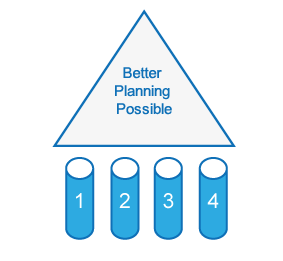METHODOLOGY
65% of the projects are delayed between 25 and 50% of their total duration, this percentage is increased proportionally to the size of the project. There are multiple means to try to avoid, or at least reduce, the probability of being delayed as well as the percentage of delay (if it happens).
Successful planning refers to a plan that does not suffer delays, or at least the delays and setbacks that it suffers are reasonably reduced, the costs are more or less in line with those planned, and the delivered product complies with the planning in terms of benefits and desired quality. This is also known as efficient development, and this is achieved by applying a good methodology for the development and management of projects.
To achieve this type of planning, also called "Best Planning Possible", we must rely on the four pillars of planning:

1. Avoid classic mistakes
2. Respect the the theoretical bases of development
3. Carry out an efficient risk management
4. Use planning-oriented methods
There are many aspects that must be taken into account to achieve the solidity of these four pillars. Our methodology is based on the use of standard procedures and tools and on the practical experience of the authors of it. Its life cycle is the so-called modified waterfall with delivery by stages.
This model uses incremental development techniques combined with agile methodologies, taking advantage of all the benefits of cascade model control, but allowing partial deliveries of modules with the flexibility of agile methodologies, which could allow us to be debugging a module as others become available. they develop others. Unlike pure agile methodologies, this combined life cycle provides greater control and visibility of the project in the short, medium and long term. Methodologies such as scrum are used in each internal iteration of the system and in the final stage of post-delivery adjustments.